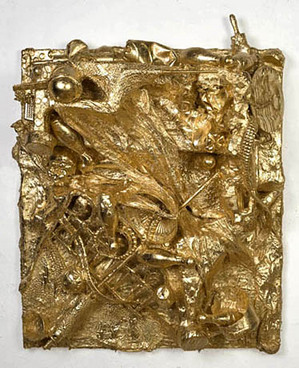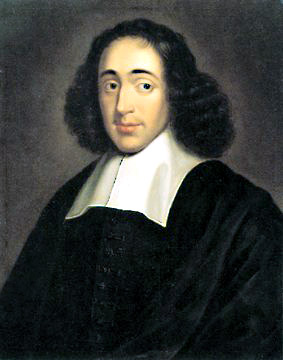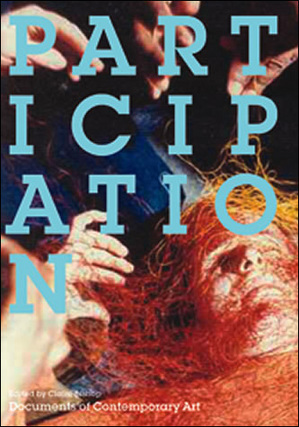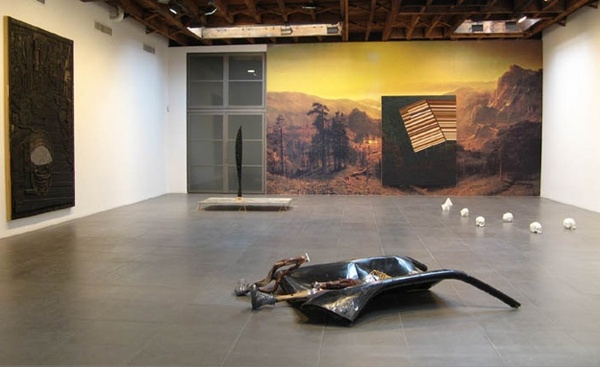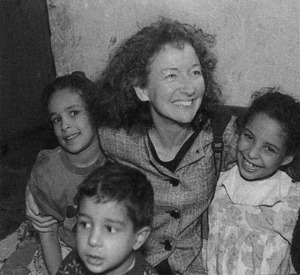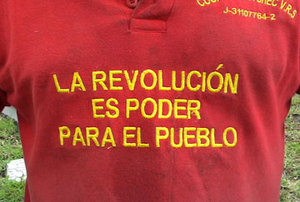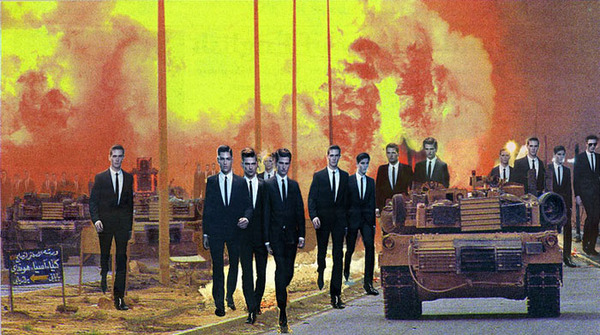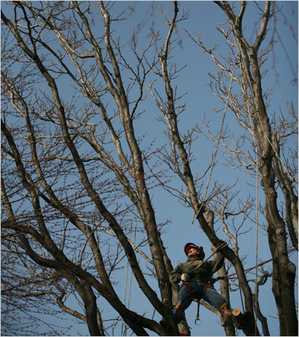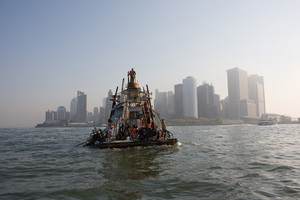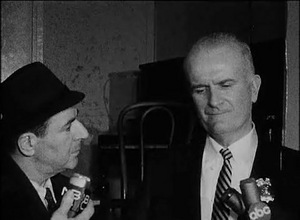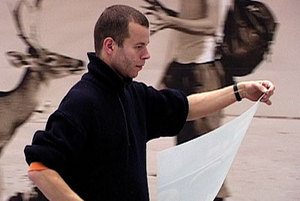This is an archive of the ArtCat Zine, 2007-2009. Please visit our new project, IDIOM.
October 2008
Simon Critchley: The Heights of Ecstasy
8-10pm Friday 31 October 2008
Cabinet - 300 Nevins St, Broolyn NY
Tonight at Cabinet's new event and exhibition space in Brooklyn, philosopher Simon Critchley will deliver a performance lecture, or sermon, while situated in a very tall wooden chair. Ever faithful to the Cabinet aesthetic, the lecture's topic will quite naturally be elevation: on thinking, ecstasy, and self-deification. The event is co-presented by the Slought Foundation, a Philladelphia based not-for-profit that produces, publishes, exhibits, and distributes work by artists, architects, and intellectuals. Slought is tonight celebrating the release of their new DVD series, which will feature discs on the work of tonight's guest as well as others including Werner Herzog, Dennis Oppenheim, Alain Badiou, and Vito Acconci. The event is free and no RSVP is necessary.
Ad Hoc Vox: On Criticism
7pm Thursday 30 October 2008
Guild & Greyshkul - 28 Wooster St New York, NY
Tonight at Guild & Greyshkul, Jennifer Dudley and Colleen Asper present the latest installment of Ad Hoc Vox, a developing series of migrating panel discussions on contemporary art. On Criticism brings together several very active figures in the arts community to discuss the relevancy of critical writing today. Judging by the participants lined up for evening, the fulcra of the event seem to be issues of critical writing as a component of other creative work, the agency of such writing and writing in an age of highly visible digital self-publishing. Speaking tonight will be painter and writer Roger White, founding co-editor of Paper Monument, n+1's sister journal of the arts; João Ribas, critic and curator of the Drawing Center; artist John Miller; Artnet's Ben Davis; critic Martha Schwendener; and critic Jan Avgikos.
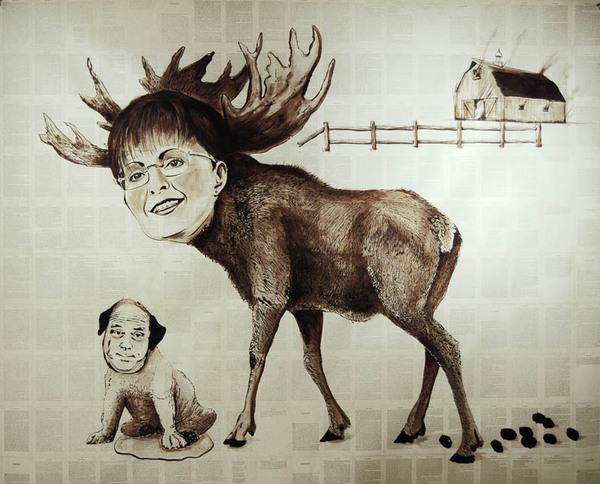
Party Headquarters: Voting is Just the Beginning
Curated by Eleanor Heartney and Larry Litt
September 26 – November 4, 2008
Pratt Manhattan Gallery
Joining the numerous election-oriented exhibitions that have opened around New York City since the start of the season, the Pratt Manhattan Gallery departs from a prevalently grave approach to the topic and focuses instead on satirical politics. The works included in Party HQ range from simple renditions of iconic images to sharper critiques of political personalities.
In conjunction with the exhibition, Allan Wexler has constructed a collapsible voter registration booth comprised of several pegboard sheets that are held together with an American flag. Starting August 28th and until the final day of voter registration in early October, Wexler erected the booth in various locations around New York City in order to encourage and enable people to register to vote in the upcoming general election. He purportedly registered 500 new voters through his efforts, some of which are documented in the exhibition. Also on view are three black ink drawings by veteran artist Arnold Mesches, which depict scenes from the RNC and DNC — another form of political dedication. Capturing their true zeitgeist, Mesches outlines the material density and chaotic atmosphere inherent to these intense events.
to: Night -- Contemporary Representations of the Night
Curated by Joachim Pissarro, Mara Hoberman and Julia Moreno
Bertha and Karl Leubsdorf Art Gallery - South West Corner of E 68 St and Lexington, New York NY
25 September - 6 December 2008
Times Sq Gallery - 450 W. 41 St, New York NY
25 September - 15 November 2008
In response to Van Gogh's Colors of the Night exhibition at MoMA, a show at Hunter College wonders how the legend would depict the starry night if he were alive today. to: Night - Contemporary Representations of the Night explores night with the digital techniques and high technological mediums of our moment. Most of the works are not paintings but share Van Gogh's wild comfort level with risks that only the future could admire.
The starry sky twinkles everywhere in the show. Stars shine beside dark surroundings with an audacity that's irresistibly admirable. The light's scarcity makes their illumination precious. There is an ancient stillness at night that lends itself to gazing up and enjoying the stars that many of these works capture.
The challenge of depicting the night sky is that it becomes monotonous to staple a dark background with evenly spaced silvery dots. That star field screensaver got to be so boring. Van Gogh was on the right track when he embraced the Milky Way. He weaves the curvilinear flourishes of art nouveau into a glowing lace at the center of his famous picture. Yellow stars orbit around that silver nebula like planets and move the eye around the picture. Only Jen DeNike and Robert Longo mined the full potential of the Milky Way and their sky's swirl with a formal density. Perhaps the light polluted city sky and screensavers deeply shapes how many artists see the night.
Vija Clemins reveals another strategy to keep the evening sky engaging. At first, it appears guilty of the screensaver's boring uniformity. But as your eyes adjust to her visual language, one starts to detect the subtle different intensities with which her stars shine and twinkle. In such an overstated era like our own, such understatement is refreshing.
Dark rooms with illuminated installations recreate that nocturnal scarcity of light that makes it so precious. The blackest space requires some retinal patience. The works are so dim and the room so dark that only dilated eyes can perceive the starry landscapes. Lauren Orchowski presents more three dimensional dioramas of nocturnal landscapes. Her works focus on that moment of twilight when the last remnants of the sunset still linger in the sky. The spindly trees and crumbly architecture hit the Halloween appeal without going overboard. Glowing trees with autumn's bright colors stand in Doina Kraal's dark room.
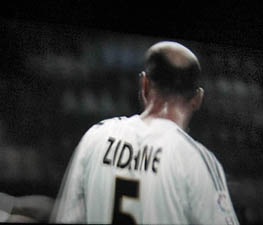
Zidane, A 21st Century Portrait
7pm and 9pm, 27 - 30 October 2008
Anthology Film Archive - 32 2nd Avenue, New York NY
$8
Now through Thursday, 30 October, the Anthology Film Archives will be presenting nightly screenings of Douglas Gordon and Phillipe Parreno's Zidane, A 21st Century Portrait, a film work from 2006. Working with seventeen film cameras and various live video feeds -- all focused on Zinedine Zidene, the former French football midfielder, as he played a match late in his professional career for Real Madrid against the Villarreal football club -- the two artists collaborated with editor Herve Schneid to create a realtime 90-minute portrait of the athlete deeply involved in his work. The result is a work more in the legacy of Warhol's film portraits and less of the painterly or photographic traditions. It is as committed to the grand aspirations of a spectacular, highly produced representation as to its unyielding interest in the central figure in motion. The film will be showing twice each night at Anthology from as the original 35mm print (a mass produced DVD edition was recently made available to German audiences for less than $20), and coincides with the recent opening of anyspacewhatever at the Guggenheim, an exhibition in which both Parreno and Gordon participated. The film will be co-presented at BAMcinematek several times this week as well.
Spinoza in His Time and Ours
October 27, 2008 - 6:15 pm, Columbia University
Heyman Center for the Humanities
It's hard to say exactly when the full frontal Spinoza revival began, exactly, but whenever it was, it certainly shows no signs of abating. Verso's recent republishing of Etienne Balibar's study, is just the latest in what has become a deluge of Spinoza studies, both popular and more esoteric. In addition to Balibar, Negri, Deleuze and Macherey have all published studies on the man. Perhaps the relative success of these thinkers attempts to turn Baruch into a proto-Marxist will be gauged this Monday, when Susan James and Jonathan Israel will examine the continuing applicability of Spinoza's ideas, with special emphasis on the political. The lecture is free.
Catalysts and Critics: The Art of the 1990s
9:30am - 5:30am Friday 24 October 2008
Columbia University, School of the Arts - Broadway at 116th St,
Havemeyer Hall, Room 309
New York NY
$15
Doing Art Politically: What Does This Mean?
A lecture by Thomas Hirschhorn
6:30pm Friday 24 October 2008
Cooper Union, The Great Hall - 7 East 7th Street, New York NY
In many ways, with his 1998 book Relational Aesthetics, and later Postproduction, Nicolas Bourriaud did precisely what he set out to do: that is, develop and popularize a certain critical vocabulary to talk about a breed of interdisciplinary event- and socially-oriented art practice that had experienced a particular refinement during the 1990s. The work of course did various other things beyond this ambition, the kind which any serious critical or art historical stake on such a legacy would provoke. A line in the sand was drawn, a very stark line, which inspired all kinds of aggressive positioning and re-positioning to its relation by various producers, of both art and texts. What a rare opportunity, then, for any observer of this highly visible and important group of Bourriaud's, his friends and detractors, and the dense cosmos of participatory art, for the Guggenheim to have organized Catalysts and Critics: The Art of the 1990s at Columbia University, taking place most of this Friday. A broad spectrum of opinions and allegiances will be present at the conference, with contributions by critics Alexander Alberro, Ina Blom, Nicolas Bourriaud and Claire Bishop; curator Nancy Spector; noted collector Andy Stillpass; gallerist Massimo de Carlo and scholar Jose Falconi. The event is organized on the occasion of the opening of anyspacewhatever, a major new exhibition at the Museum in which a core group of 10 artists -- Angela Bulloch, Maurizio Cattelan, Liam Gillick, Dominique Gonzalez-Foerster, Douglas Gordon, Carsten Höller, Pierre Huyghe, Jorge Pardo, Philippe Parreno, and Rirkrit Tiravanija -- have been invited "to collectively formulate a scenario for an exhibition, one that will reflect and articulate the unique nature of their practices."
Curiously enough, also tomorrow, Swiss artist Thomas Hirschhorn will be presenting a lecture at the Great Hall of the Cooper Union entitled Doing Art Politically: What Does This Mean? at 6:30, the second in Cooper's Art and Politics as Usual event series.
Patrick Cockburn
OUT NOW! Lecture Program
7pm Wednesday 22 October 2008
Cooper Union, Great Hall - 7 E 7th St, New York NY
Tonight a Cooper Union's historic Great Hall, journalist Patrick Cockburn presents a lecture tonight entitled Why America Will Have to Get Out of Iraq Regardless of Who Wins the Presidential Election, arguing for an Iraq that has always and overwhelmingly been opposed to U.S. occupation. Cockburn was been a Middle East correspondent since 1979 and currently performs so for The Independent of London, as well as writing a regular column for the Nation. He has written four books on Iraq and has collected two major journalism prized: the James Cameron Prize in 2006 and the Martha Helhorn Prize in 2005. The talk is part of the event program for OUT NOW!, an exhibition organized by Anton Vidokle and on view at e-flux's New York location through 8 November.
Terranaut
Matthew Day Jackson
Peter Blum Gallery, Chelsea - 526 West 29th Street, New York NY
12 September - 8 November 2008
Matthew Day Jackson's exhibition at the Peter Blum Gallery's Chelsea location resists palpable interpretation. Titled Terranaut, the melange of thematically related sculpture and paintings instills a conflated unease, a sense of simultaneous death and birth. One exits trying to remember the difference, his conceptions of finality and creation faltering.
Jackson works with found objects and recontextualized materials. Dead or discarded things -- tree branches, roots, car parts, old cloth -- are reborn as symbols of death. Dymaxion Skeleton, set off by itself in dim alcove, borrows Buckminster Fuller's design for a sculpture of a Dymaxion skull propped up by a skeleton of lithe wooden debris, lit from the floor of a close-fitting, coffin-size box with three mirrors on each interior wall. The whole effect is similar to a skeletal model used for demonstrations in anatomy lectures, using the discoveries from death to display the workings of life -- all in order to, of course, prevent death and prolong life.
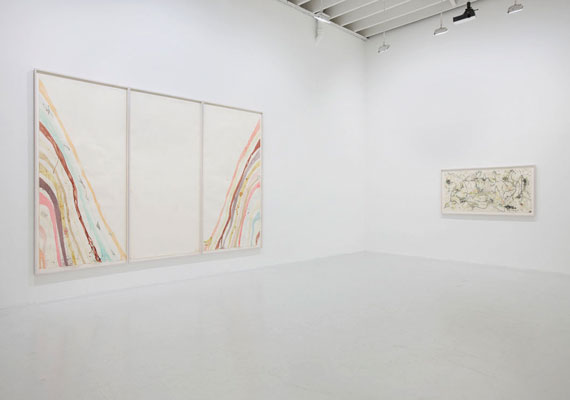
Man Eater
Aurel Schmidt
Deitch Projects - 76 Grand Street, New York NY
4 October - 1 November 2008
There's nothing wild about Man Eater, Aurel Schmidt's debut at Deitch Projects. Here she reinterprets modernist masters in the form of city detritus. Jackson Pollock's Number 8 is recast as Everything Means Nothing To Me, a listless punk assemblage of moist wipes, condoms, dead sparrows, maggots, flies, worms, lipstick, caps to Duane Reade prescriptions, and various brands of cigarettes. Willem de Kooning's Woman And Bicycle becomes Like A Fish Needs A Bicycle, an act of feminist defacement in which the depicted figure's grin is transformed into candy colored dildo lips with cigarette teeth, while her breasts become mice and car deodorizers. While the sexualization of female subjects by certain modernist painters seems to offend Schmidt, what her own work achieves remains unclear. Her drawing ability is undercut by her unfocused vision. The largest work in the exhibition is Schmidt's take on Morris Louis' Alpha-Pi, titled So Damn Pure. Images of bloody Band-Aids, partially-chewed take-out, rainbow M&M-chip cookies, and sardines fill the blocks of color she saturated with urine, beer, and Kool-Aid. By reinserting clear pictures into a form meant to dispense with imagery, and taking her subject matter for her medium, her version appears overstuffed.
Schmidt is not Tony Shafrazi tagging Guernica in 1974, nor is she Valerie Solanas advocating the Society to Cut Up Men. She's merely angsty by comparison. Of her mission, the press release says that Schmidt "sees the progression of Modern Art as chasing a purity she seeks to problematize." She interprets this literally by converting the line of the original brush strokes into trash. In terms of the abstract expressionist paintings she's chosen, purity can have a variety of meanings. She could be referring to the artists' unbridled subjectivity which guides some of these works. Pollock, among others, imagined a beyond behind the canvas, where the physical act of creation became as important as the final work itself. She might also be referring to the relationship between ideology and technique. Abstraction -- freedom from the symbolic and representational baggage of painting -- reflected the spirit of a liberal, post-war market of ideas and commodities, long since in the historical making. We see the techniques and forms of modern painting divested of their political and intellectual significance. Man Eater is charming and rebellious fun, but hopefully her future work will treat these art historical trajectories with the same precision of her lines. The effect is otherwise existential Where's Waldo: What are we searching for?
Bruce Conner's canonical gestures -- from the splashes of film leader, to the blank shocks of violence and repetitive imagery native to his short films -- were on full display this past Tuesday at Light Industry's most recent offering, Crossroads: A Tribute to Bruce Conner. A neat paean to the pioneering film and collage artist who passed away earlier this July, Crossroads took a look at the shaggy filmmaker's legacy in the works of 25 artists of several generations, working with various media.
The tribute's selections were mostly bite-sized and borrowed from a variety of sources, true to form to many of Conner's shorter, found-footage films. Luther Price's Inside Velvet K, with its mid-century footage of clinical tests, maggots, and solar flares, has the same apocalyptic ring and grainy found aesthetic of Conner's most famous work A MOVIE. Dara Birnbaum's whipsmart Pop Pop Video, a dissection of television gunshots and wounded howls chopped with test patterns (TV's equivalent of Conner's favored black leader) is a slick, New Wave treatment of Conner's favorite topics of media and violence. Amongst these rougher patches were cartoonish oases of critique -- Conner's forte. Animal Charm's Edge.TV, remixed the talking-pets blockbuster Homeward Bound into a humdrum (and brilliantly comic) montage of empty front yards and babbling animals. Bradley Eros' l'oop, a film collage built upon a blueberry-hued clip of Olive Oyl, is shot through with snippets of ethnological footage and boasts a soundtrack of Nancy Sinatra, Woody Woodpecker's cackle, and Popeye's tuneful groans.
Conner's persistent and effective use of music in much of his work -- at one time or another he'd worked with Toni Basil, Devo, Brian Eno and David Byrne to essentially create the music video -- was present in the anxious throb of Roger Beebe's TB/TX Dance; John Michael Boling and Javier Morales' frenetic, screen-obsessed Blast Yr Body; and Oliver Laric's 50 50 2008. In the last work, appropriated snatches of various YouTubed fan-made renditions of 50 Cent's In Da Club are edited into a seamless music video. Laric's digital cut-and-pastes become a wry translation of the film editing hand, while the artist imagines YouTube as the new cutting room floor and Conner's films as an artistic blank check.
Kathy Kelly: Witness Against the War
Lecture - Thursday, October 16, 2008 - 7:00 p.m.
Wollman Auditorium - 51 Astor Place - Free
The sheer reactivity of the left over the past eight years is obvious to even the causal observer. Rather than proffer a convincing explanation of the current situation in historical, economic, or cultural terms, the opposition has too frequently been content to simply denounce whatever initiative, plan, or action has been taken by the White House. For a political tendency that, historically, has been overdetermined, theoretically and otherwise, in the extreme, this sudden impoverishment is more than striking, it is depressing.
Nowhere has this tendency been more on display than in the reaction to the Iraq War. Indeed, it is the rare activist who has had the temerity to point out the obvious: that the United States has been at war in Iraq for almost twenty years, and prior to that was hardly neutral. Regardless of the level of the CIA's involvement in actually installing Saddam Hussein, he certainly received significant support from America (and the Soviet Union, actually) in his long and bloody campaign against Iran. The displeasure towards what is really only the most recent chapter in a long and dismal story seems either naively arbitrary, or sadly selfish, when viewed in historical context. We are happy to starve children and bomb wantonly, but an invasion really puts us out.
Kathy Kelly is one of those who has consistently sought to draw attention to this ongoing state of affairs - though another coming immediately to mind, it must be said, is Ward Churchill - whose now infamous polemic On The Justice of Roosting Chickens was actually aimed at US sanctions in Iraq. Kelly, for her part, has worked frequently with Voices in the Wilderness, visiting Iraq over twenty times since 1996, and living there during the invasion of 2003. She is also involved with Voices for Creative Nonviolence, and most recently spent five months working with displaced Iraqi's in Jordan. Tonight she will discuss "ways for ordinary people to campaign on behalf of just and fair US policies toward Iraq."
Art and Commerce: Alternative Economies; Christine Hill and Rirkrit Tiravanija
6:30 Thursday 16 October 2008
MoMA, Titus Theater 1 - 11 W. 53rd St, New York NY
$10
Several weeks ago Holland Cotter, writing for the New York Times, penned a slightly ambiguous review of Demonstration Drawings, Rirkrit Tiravanija's solo exhibition hanging now at the Drawing Center through 6 November. The Times' senior critic seemed generally sympathetic to the show, commending Tirvanija's efforts at two particular moments. First, there is the excitation of the not uninteresting creeping guilt of a commercially viable practice, what Cotter in other words describes as "the divide, if it exists, between art’s vaunted relevance and its luxury-item status." Then, of course, there is the equally platitudinous, though perhaps likewise not uninteresting, contradiction evoked by a show that points to a difference "between the truth of history and the truth of the recording hand." Who can resist however, answering to the first matter, if one is at all familiar with Rirkrit's practice, not just as an artist, but as an organizer, a member of various communities, and a teacher. Cotter implicitly criticizes Rirkrit's practice for a soft exploitation in the form of lump -- perhaps low -- sums paid to the worker-artists who produce the drawings that are "already bought or for sale," and for which "Mr. Tiravanija will collect whatever further profit" following their deinstallation. And yet, even in Cotter's narrow perspective of the situation, Tiravanija isn't completely to blame. Certainly not in world of grand patronage and market rule through which the show seems to elegantly waltz.
Never mentioned in the piece are the the final destinations of much of the profits generated from such salable work by Tiravanija, the most ambitious and important of which is undoubtedly The Land Foundation, an experiment in self-sustainable organization emerging from the arts which Tiravanija and several other artists founded in 1998. Privately purchasing a plot of agriculturally unattractive land in Northern Thailand and developing it steadily since, The Land is one in a series of commercially unmotivated models in self-organization and artistic agency to emerge from a larger group of colleagues of Tiravanija's, and many of which are non-entrepreneurial and in fact self-funded. Aside from functioning as a platform for Tiravanija and his collaborators to build architecture and enact various other projects, artistic or otherwise, The Land Foundation, like the land on which it rests, was from the start imagined, and in fact has become, a community hub: offering scholarships, funding and live/work spaces to a local community as well as functioning as a landing pad for an international roster of artists and cultural workers wanting to realize projects outside of that brutish, market-oriented world Cotter accuses Tiravanija of navigating with such acumen.
Thursday 16 October at MoMA, Rirkrit Tiravanija along with artist Christine Hill will present a talk entitled Art and Commerce, perhaps on just such alternative economic models. Hill herself is well known for a project called the Volksboutique, a long-term engagement that is sometimes an entrepreneurial performance, and others a model for ensuring artistic autonomy. The conversation will be moderated by MoMA director Glenn D. Lowry.
Parsons Fine Arts Lecture Series: Carlos Motta
3:15-5pm Wednesday 15 October 2008
Parsons, Kellen Auditorium - 66 Fifth Ave, New York NY
Tomorrow afternoon artist Carlos Motta presents a talk as part of the Parsons Fine Arts Lecture Series. Motta is one of this year's Guggenheim Fellowship winners, and most recently presented his three year project La Buena Vida (The Good Life) at Creative Time's Democracy in America: Convergence Center, an exhibition curated by Nato Thompson. Motta's The Good Life is a collection of pedestrian interviews across twelve Latin American nations. The conversations between the interview subjects and the artist return to questions of perceptions of the United States foreign policy and democratic government in general, reflecting a diverse, and sometimes confused, spectrum of political opinions in a post-Colf War World. All of the videos that constitute the project are also available for viewing in an online archive, accessible via the project's website.
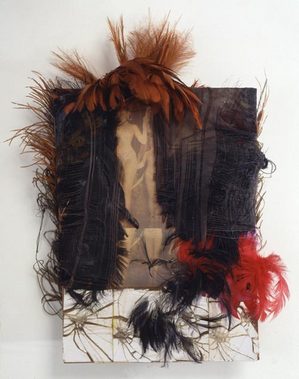
Crossroads: A Tribute to Bruce Conner
8pm Tuesday 14 October 2008
Light Industry - 55 33rd Street, 3rd Fl, Brooklyn NY
$6
Tomorrow evening, Light Industry in Sunset Park, Brooklyn, presents Crossroads: A Bruce Conner Tribute, a program of motion picture works selected for a memorial to Conner, who passed away this past July. Conner as an artist worked across mediums, exhibiting his paintings, sculptures, assemblage and works on paper since the mid 1950s. Coming out of a conventional American art training, Conner began making films a few years after completing his undergraduate degree, shortly thereafter inscribing himself in the narrative of American experimental cinema with several now canonical works of found-footage 16mm film. Conner's films are described by film historian P. Adams Sitney, along with those of colleagues like Ron Rice and Christopher Maclaine, as a mid-century west coast Beat aesthetic. They are lyrical, playfully mythic, often quickly cutting, and potentially appealing to a non-specialized audience, while simultaneously incorporating sophisticated metaphors and shifting symbolic baggage. Conner's first completed film, A MOVIE, 1956, remains one of his most popular, consisting of a dense 12-minute collage of appropriated film sequences from various fiction and non-fiction films masterfully split and cut with black leader. Among the general sensational thrust of the images which make up A MOVIE -- of sexual enticement, modern warfare and its equipment, industrialized transportation, human recreation, car and plane crashes, animal life and ethnographic documentary -- there lies buried, late in the film, another defining image of the 20th century: the atomic blast executed by the U.S. Government as a test at Bikini Atoll on one of the Micronesian Islands of the Pacific Ocean. This image, appearing briefly in A MOVIE, is elaborated upon in Crossroads -- the work lending its title to the evening's screening -- in which we see the infamous Bikini Atoll test footage slowed down and reprinted to make the entirety of the equally mesmerizing and terrible 36 minute film.
An intergenerational roster of artists have contributed work to be shown on the occasion including Peggy Ahwesh, Craig Baldwin, Dara Birnbaum, Ken Jacobs, Eileen Maxson, Keith Sanborn, Bradley Eros, Ernie Gehr, Michael Robinson and others. Part of the evening's proceeds will go to benefit Anthology Film Archives's preservation of Bruce Conner's films.
GREAT POWER
Martha Rosler
Mitchell Innes & Nash - 534 West 26th St, New York NY
6 September - 11 October 2008
There are a lot of things to dislike in Jerry Saltz' recent jeremiad against Martha Rosler's GREAT POWER in the pages of New York Magazine. First, and most embarrassing coming from a committed formalist like Saltz, is the casual mendacity of: "Four decades later, Rosler turns out not to have changed the look of her own work at all." Even granting that the "look" of Rosler's collages in GREAT POWER does not depart from her sixties-era series Bringing the war home… -- because, you know, that's entirely the point -- we are apparently expected to believe that the last time Saltz has had any exposure to Rosler's work was four decades ago. This simple impossibility, for a critic of Saltz' unique dedication, allows him to emit absurdities along the lines of "The only thing her work says is that fashion designers and women who like to shop caused two wars," before moving quickly past the art he was hired to review and onto more interesting topics.
It is not really my intention here to defend GREAT POWER, it is a difficult, and in many ways an unsatisfying presentation. I suspect this is the point. Regardless, what most certainly cannot be said about it is pretty much anything Saltz' says about it. It is not superficial. It is not a nostalgia trip. It is a pointed and examined deployment of representational strategy by an artist whose career is a noted catalog of such engagements; four decades worth, as it turns out. If it makes sense for anyone anywhere to pose the question of the relationship between the current political and cultural unpleasantness and the vintage variety, it is Rosler. Indeed, what is ultimately so depressing about Saltz' piece it that he is only too happy to miss the point entirely, making that rankest of amateur confusions: conflating his emotional response with his ultimate judgment -- it makes him mad, so it must suck.
But, to paraphrase, Saltz' review is simply stupid. What it points to however, is far more interesting and widespread. There are two passages in particular that I want to examine.
This is the first.
Clearly, there are parallels between the two wars, and activist art is valid. But Rosler lapses into simplistic nostalgia and undermines her older work while basically making pretty war porn.
And the second.
Anyone who thinks any of this is good art, effective activism, or even slightly radical needs to get a grip.
What is the relationship here between activism, radicalism, and good art? Saltz initially allows for the 'validity,' of 'activist art,' setting up, it would seem, the question he later begs quite explicitly: would it be possible for Rosler's work to be effective activism and bad art at the same time? It doesn't occur to the critic to formulate this question outright because he's too busy being aggressively bored, but it's an important consideration. Why does he have to discredit it both as activism and as art? Never mind the easily assumed authority in judging activist strategy! What Saltz seems to be engaging with, in his own resentful, teeth-gritting sort of way, is precisely that Brechtian legacy of which Rosler's career, at times more and less effectively so, is perhaps our clearest example. Brecht's fundamental contribution, it must be remembered, was not a specific piece of writing -- it is the rare artist, theatrical or otherwise, who can name more than three of his plays -– but rather an almost ontological subordination of art to politics. And, reciprocally, that persistently difficult claim, especially for critics, that all art ought to in some way deal with or approach political questions; that, in fact, the two cannot be separated. All art is political, there is only work which realizes this fact, and behaves accordingly, and that which doesn't and risks supporting the (unacceptable, naturally) status quo by its claims to being a-political. It's the old "you're either with us or against us" mentality; no doubt you've heard of it.
(re)Generation: Three Artists, Three Cities
3pm Sunday 12 October 2008
9-01 33rd Road, Long Island City NY
$admission (10)
This Sunday, 12 October, the Noguchi Museum in Queens will host (re)Generation: Three Artists, Three Cities, a panel discussion organized around the recent loss of the Museum's Ailanthus tree, the sole plant life original to the junkyard on which Isamu Noguchi founded the museum. Mitch Cope and Ingor Vetter, co-founders of the Tree of Heaven Woodshop were earlier this year asked by the Museum to mill and create objects from the wood of the Ailanthus, and will be present to partake in the panel discussion. Also taking part will be Paul Villinksi and Annie Murdoct who took part in Waste Not, Want Not, an exhibition at Socrates Sculpture Park where the solar-powered kiln used to mill the tree was housed. Curator Lilly Wei will moderate the panel.
Conversation with Ann Messner, Kiki Smith, and Swoon
7-9pm Thursday, October 9th, 2008
Deitch Studios 4-40 44th Dr., L.I.C., Queens
This Thursday at Deitch Studios will be a conversation between Ann Messner, Kiki Smith and Swoon. Moderating will be Carlo McCormick. Street artist Swoon, known for her remarkable work in wheatpaste and cardboard cutouts, currently has an installation at the Studios. The installation includes the seven floating sculptures that served as the basis for Swoon's latest project, a collaboration with playwright Lisa D'Amour and Minneapolis band Dark Dark Dark among others. Swimming Cities of the Switchback Sea was a meandering flotilla, a performance series, and shooting location for Todd Chandler's film Flood, sections of which will be shown prior to the talk.

A Rare Breed - A Portrait Series on Redheads
Julia Baum
NY Studio Gallery - 154 Stanton, New York NY
4 September - 27 September
Red hair was the theme of a recent portraiture show of photographer Julia Baum at the New York Studio Gallery on the Lower East Side.
Blank white backgrounds stoke the fire on these scalps. The garments the subjects wear are likewise muted and resist screaming with busy patterns. The textures and colors of the vermillion strands immediately grab the viewer's attention. Baum's fauvist eye for bold color is tempered by the shutter's literalism but never entirely suppressed.
Red hair fans out across a wide spectrum of shades. But there are scant occasions to appreciate this variety as two carrot tops rarely stand side by side. Glowing bonfires of hair contrast starkly against duller heaps of terracotta. Before connoisseurship became a dirty synonym for narrow minded elitism and neo-phobia, it was once associated with relishing such subtle distinctions between colors, lines and shapes. By bringing so much red hair together, Baum taps into this presently undervalued joy of viewing.
Leslie Hewitt at Parsons
Parsons School for Design, Kellen Auditorium - 66 Fifth Ave., New York NY
3:15 - 5:00pm Wednesday 8 October 2008
This Wednesday the the Parsons School of Design, artist Leslie Hewitt will present a lecture on her work. This year at the Whitney Biennial, Leslie Hewitt collaborated with William Cordova to install I Wish It Were True at the Park Avenue Armory -- a library of bootleg VHS tapes constituting an ambitious library of revolutionary-themed alternative and little distributed films on Black and Latino liberation topics. The attached screening room along with the library found itself something between an art of utility and an aesthetic experience in time. Make It Plain meanwhile, a series of large photo prints by Hewitt also in the Biennial, presents various smartly composed images of picture frames, books, photographs and other byproducts of the sister industries of memory and history.
From Smack Mellon to the Triangle Arts Workshop, from artist studios to loading dock installations: DUMBO was decked out for its role as one of Brooklyn's premier art festivals: the 2008 Art Under the Bridge weekend.
While I got to see a healthy chunk of what was on display, I kept overhearing people talk about cool things I missed like the performance artist who bartered objects with the public or the artist who unfurled a blanket on the rocky shores of the East River. It was a rainy day under the Manhattan Bridge but no one seemed to notice.
In Ken Jacobs' Perfect Film, 1985, we see what looks to be two unedited sound interviews on sharp black and white film, both recorded in single, long takes. The scene is quickly revealed to be New York, the year is 1965. Malcolm X, the sometimes polarizing African American human rights activist has just been fatally shot in the Audubon Ballroom, in Manhattan's Washington Heights. We see unfold the observations and reactions of two men on screen as they answer questions that come from on- and off screen interlocutors. The first is an unidentified African American Harlem resident who speculates on Malcolm X's importance to America and the Harlem race riots that had just transpired the summer before. The second interview meanwhile is between a number of journalists and an unidentified white police inspector in a suit and striped tie whose responses to the questions asked seem to shift from edgy to flat. With the two interviews come the various subtle austerities of raw film footage: we see a false start, each subject's preparation for the camera, an inappropriate grin, a pregnant silence.
Following the two interviews is a cut to silence as we see various street scenes, images around and inside the Audubon, and finally, interior views of the apparent scene of the crime where a police officer points with a nightstick at a marker on the floor while camera flashes fill the room with light. The film is something of a time capsule of course, and has all the weight of a historical document, which it certainly is. First, for Jacobs, who found the footage in 1985 -- several discarded news rushes arbitrarily spliced together and sold to the filmmaker for the price of the reel they ware on -- and secondly for the contemporary viewer, who encounters images so heavy with historic residue that the filmmaker himself, who had not otherwise shied away from the use and manipulation of found-footage, judged the raw film perfect, requiring no intervention on the editing table whatsoever. Jacobs' decision to put the orphaned images back into circulation, framed now only by a title, has resulted in a complex and arresting work. It is a film that one might imagine, without great difficulty, inspiring a generation of certain certain younger media makers like Walid Raad and Matthew Buckingham.
Jacobs writes on the film:
I wish more stuff was available in its raw state, as primary source material for anyone to consider, and to leave for others in just that way, the evidence uncontaminated by compulsive proprietary misapplied artistry, "editing", the purposeful "pointing things out" that cuts a road straight and narrow through the cine-jungle; we barrel through thinking we’re going somewhere and miss it all. Better to just be pointed to the territory, to put in time exploring, roughing it, on our own. For the straight scoop we need the whole scoop, or no less than the clues entire and without rearrangement. O, for a Museum of Found Footage, or cable channel, library, a shit-museum of telling discards accessible to all talented viewers/auditors. A wilderness haven salvaged from Entertainment.
Perfect Film is one of twenty works currently being shown by the online film and video exhibitor tank.tv. A major exhibition curated by Mark Webber and spanning just over 50 years of work, the show includes several upcoming events in London and Amsterdam, and will remain on view at tank.tv's website through 30 November, 2008.
If One Thing Matters: A Film About Wolfgang Tillmans
7:30pm Thursday 2 October 2008
$8
This Thursday at Anthology Film Archives, Heiko Kalmbach's recently completed documentary on photographer Wolfgang Tillmans will be shown for one night. If One Thing Matters... is the result of four years Kalmbach spent with his subject, and depicts the latter in his own voice: working, traveling, exhibiting and producing the pop portraits, abstracts and documentary pictures for which he is so well known. The title of the film is borrowed from Tillmans' major 2003 exhibition at Tate Britain, three years after the artist became the first photographer (and non-British subject) to win the prestigious Turner Prize. The filmmaker will be present at the screening to introduce his work and answer audience questions following it.
ZINE
HOME
TIPS / COMMENTS
CATEGORIES
CONTRIBUTORS
- Greg Afinogenov
- B. Blagojevic
- Adda Birnir
- Susannah Edelbaum
- Julie Fishkin
- Paddy Johnson
- Jessica Loudis
- Christopher Reiger
- Andrew Robinson
- Peter J. Russo
- Blythe Sheldon
- S.C.Squibb
- Hrag Vartanian

